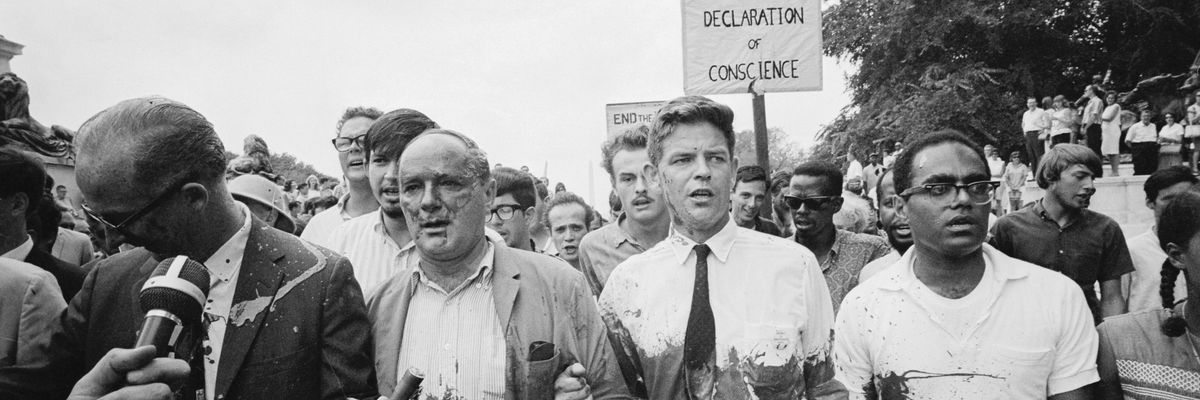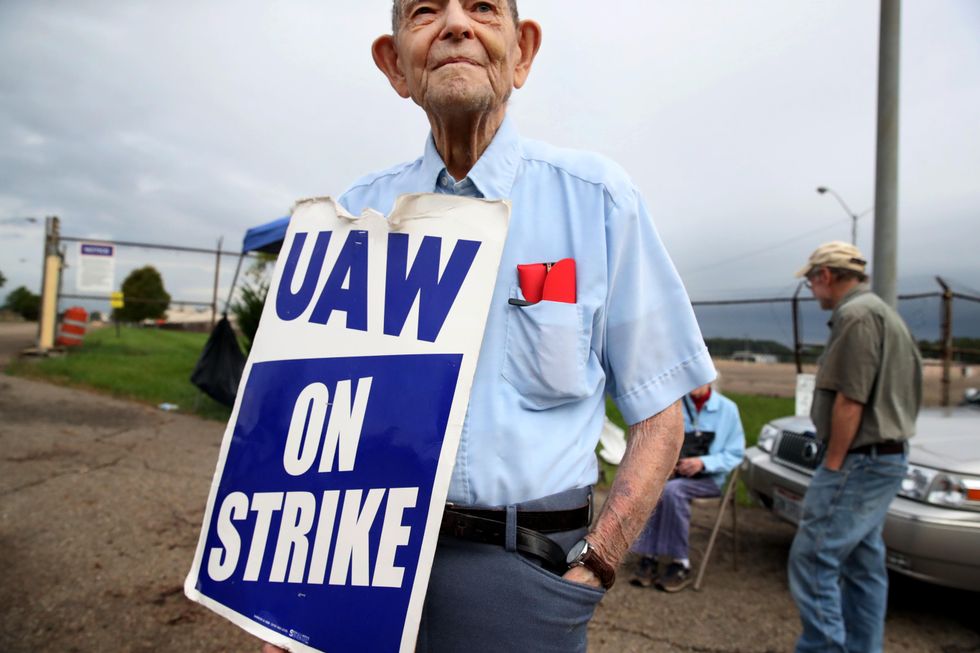One of the giants of the American Left, activist, lawyer and eminent historian, Staughton Lynd, died Nov. 17 in Warren, Ohio. He was 92. In a career that took him from the Freedom Summer of 1964 and the first organized Vietnam War protests to a national campaign to save shuttered steel mills in the Rust Belt, he straddled the worlds of the Labor Left of the early 20th century and the New Left of the '60s and '70s.
The indomitable legacy of that humble Quaker of the left will live on. The relevance of his life to a new generation of labor historians, organizers and activists is more evident now than ever.
Friend and colleague Tom Hayden referred to Lynd's ideology as "a blend of Quaker, anarchist and Marxist traditions." During the '60s, he was the model of "the historian as activist," and found himself at odds with contemporaries such as Eugene Genovese, who opposed his ascension to the presidency of the American Historical Association. In explaining the conflict between the two, Howard Zinn described Lynd's moral outlook. "Genovese saw ... Lynd as a self-righteous person because Lynd is a very Quaker type, even his life is hard to emulate." Zinn later referred to him as "an exemplar of strength and gentleness in the quest for a better world."
His parents, Robert and Helen Merrell Lynd were sociologists widely known in the field for their "Middletown" books, which applied the tools of anthropology to the study of life in Muncie, Indiana. Upon graduating from Harvard, a young Staughton sought "to combine the life of the mind and social action," as he later described it, by studying city and regional planning in graduate school. It was not to be. He moved into an ecumenical religious cooperative community--where he met his wife and longtime intellectual collaborator, Alice--before going on to study American history at Columbia.

Retired lawyer and labor activist Staughton Lynd offers his support to United Auto Workers picketing outside the General Motors plant in Lordstown, Ohio, on September 23, 2019.
After meeting the young scholar at a 1960 gathering of the American Historical Association, Howard Zinn, head of the history department at Spelman College, invited him to teach at the historically black college for women in Atlanta. Alice Walker was among his many students.
Before accepting a position at Yale, Lynd served as director of the "Freedom School" during the Mississippi Summer Project of 1964. That summer, a bridge between the Civil Rights Movement and the escalating American involvement in Vietnam opened in Lynd's mind during a speech Bob Moses gave to a Freedom School convention after the murders of civil rights workers James Chaney, Andrew Goodman and Michael Schwerner in Philadelphia, Mississippi, in July.
"He emphasized that the bodies of the young men were discovered almost simultaneously with Congressional passage of a resolution concerning the so-called Tonkin Bay incident," Lynd later recalled. "I was unaware of it until Bob spoke about it. There was a connection between these two events, Bob said. Dark-skinned people were being killed both in Mississippi and Vietnam."
Lynd's involvement with the nascent anti-war protest movement in 1965 made him a national figure and eventually ended his academic career. He chaired the first anti-war Vietnam protest in Washington with the Students for a Democratic Society in April of that year. Tom Hayden later remembered the event as a harbinger of a movement to come. "As we gazed at the unexpected crowd of 25,000, I remember Staughton dreaming out loud that someday such a massive crowd would flow over the Capitol and take the government back."
Hayden wanted Lynd to lead a national antiwar movement. "He was perhaps the only person who could unite the New Left and the Old Left, speak truth to power, and also be a persuasive advocate within the mainstream." But such a move was against Staughton's nature, and the "anti-leadership ethos" of the era precluded such a possibility, Hayden later recalled.
Hayden and Lynd attracted far more attention later in 1965 when they traveled to North Vietnam and met communist leaders, becoming the center of a global story. They documented the journey in their book, "The Other Side." At home, Lynd found himself defending the trip and his anti-war efforts on William F. Buckley Jr.'s "Firing Line" TV show, and eventually, at Yale as well.
In his academic life, Lynd's 1968 book, "Intellectual Origins of American Radicalism," broke new ground in its examination of the radical tradition in early American intellectual thought and won praise throughout the field. Nevertheless, due to his activism against the war, Yale denied him tenure. Lynd claimed he found himself essentially blacklisted in academia.
Drawn to Chicago and its long history of radicalism, he spent a few years in the late 1960s working as a community organizer with the famed Saul Alinsky. During this time, Lynd became interested in unions and the labor movement after meeting men who had lived through the CIO organizing drives of the 1930s. During a writers' workshop in Gary, Indiana, he met two socialist steelworkers from Youngstown, Ohio, developing a friendship that led him to the steel city in 1976.
The year after his arrival, the Youngstown Sheet & Tube Co. announced the closing of its Campbell Works just outside the city. At the time, it was the largest peacetime plant shutdown in American history. Lynd, who had graduated from law school while in Chicago, became lead counsel for a group called the Ecumenical Coalition, which sought to buy the mill from the company and reopen it under employee-community ownership.
"What was new in the Youngstown venture was the notion that workers and community residents could own and operate a steel mill," he later wrote in the book, "The Fight Against Shutdowns." The effort attracted international attention. Political economist Gar Alperovitz became involved with developing the plan. He had been thinking along similar lines and had co-written "Strategy and Program: Two Essays Toward a New American Socialism" in 1973 with Lynd, which developed some of the themes seen in the Youngstown initiative.
Despite getting the Carter administration to look at their plan, the government declined to provide funds needed for the modernization of the mill. Though the effort failed, Alperovitz later wrote, it inspired the founding of the Ohio Employee Ownership Center at Kent State University and foreshadowed a growth in worker-owned businesses throughout the state.
Staughton and Alice spent their later years advocating for the abolition of the death penalty and working for prisoners' rights. The couple served as co-counsel in a landmark class action lawsuit challenging the use of solitary confinement at the supermax Ohio State Penitentiary. The Lynd's also worked with men from the "Lucasville Five," accused of being the leaders of the worst prison riot in Ohio history at the maximum-security Southern Ohio Correctional Facility. Staughton wrote a history of the event in, "Lucasville: The Untold Story of a Prison Uprising."
He stayed connected with local labor organizing and international freedom movements during his final years, said writer and activist Daphne Carr. "[Staughton] urged us to join strike lines throughout Ohio. In these last years he was in constant email and Zoom contact with friends across the world, sharing manuscripts and details about struggles worldwide."
Staughton Lynd represented the best of humanity, scholarship, and activism. His passing, like that of Howard Zinn before him, turns one more page in a radical chapter of American leftism. However, the indomitable legacy of that humble Quaker of the left will live on. The relevance of his life to a new generation of labor historians, organizers, and activists is more evident now than ever.

